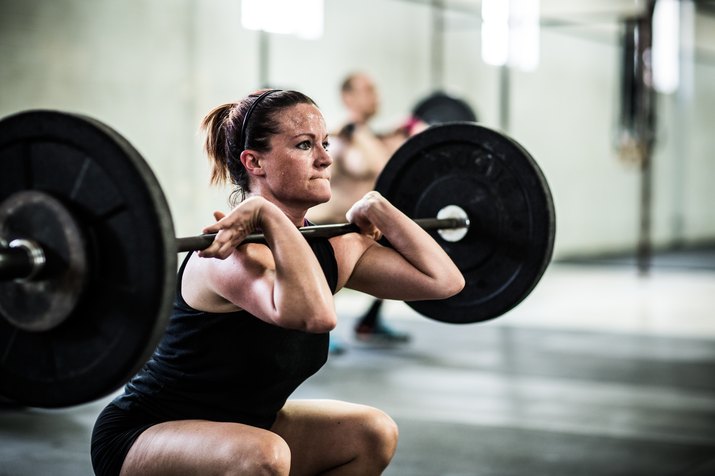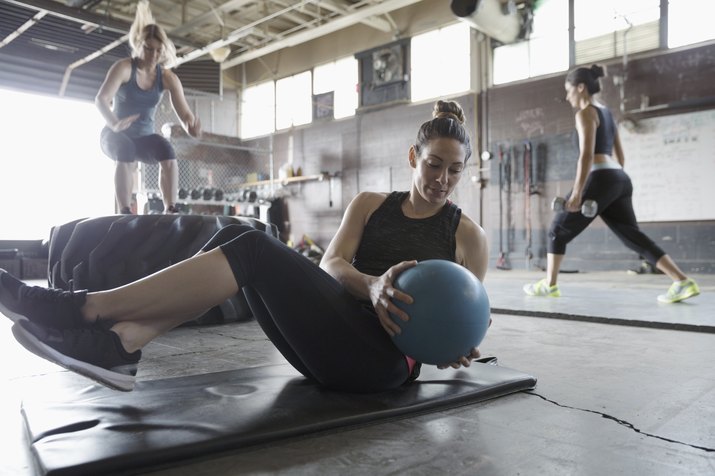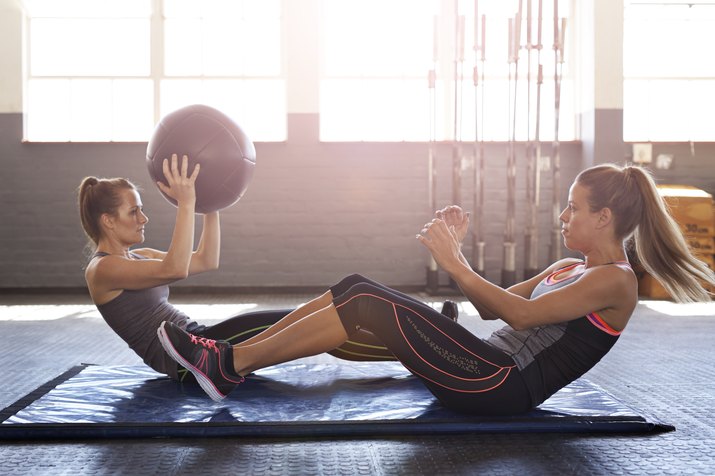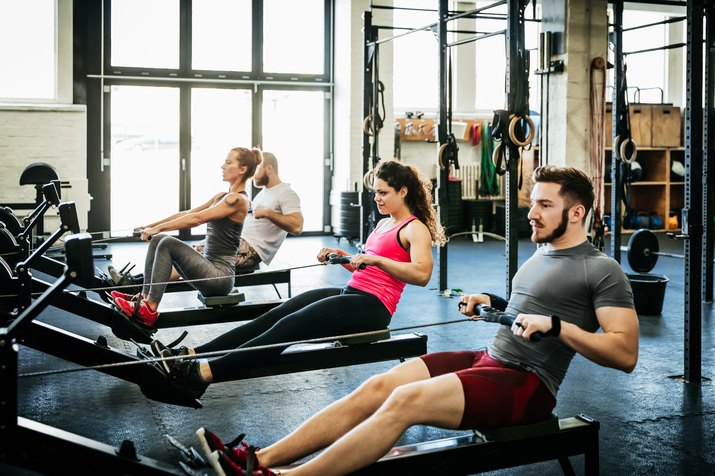
Overview
CrossFit enthusiasts are attracted to the challenging, ever-changing workouts, getting in great shape and making friends along the way. However, as the bars are raised — both literally and figuratively — so are the risks.
Rome wasn't built in a day, and the same goes for your body. CrossFitters are typically all highly motivated, focused individuals, but it's important to go easy on yourself. "Durability is more important than ability," says chiropractor and owner of LA Sports & Spine Craig Liebenson. Stay safe by avoiding these top 10 mistakes so that you can enjoy the benefits of CrossFit for years to come.

MISTAKE #1: Not Building a Base
Just like the construction of a building, you have to lay a solid foundation of strength before participating in any heavy lifting. It's easy to want to jump right to lifting heavy weights or doing five WODs a week, but it's not smart or safe. If you want to improve your fitness level, train smarter, not harder.
"Slow and steady is the best way to build an athlete. If power is at the top of the pyramid, then stability is the base," Liebenson says. Build your foundation of fitness first and then begin to increase the intensity, whether it's weight, reps or variations of an exercise. And if you're a true CrossFit beginner, look into on-ramp classes. Many CrossFit boxes will offer a six-week program where you learn to master movement patterns with little to no weight before advancing to the big leagues.
Read more: The Beginner's Guide to CrossFit

MISTAKE #2: Sacrificing Form for Reps
CrossFit is, by nature, competitive. But that doesn't mean you should sacrifice your form to pump out more reps than your neighbor. For instance, don't round your back during deadlifts, collapse your chest to the ground when doing push-ups or bend your knees inward while squatting.
All of these sacrifices put you in danger of injuring yourself. "When you sacrifice form for quantity, you are always taking a chance," Liebenson says. Nothing is as important as proper form. Most of the movements in CrossFit require a high power output with heavy weight. If done properly, you will benefit exponentially. If movements are done in an incorrect manner, you will only suffer.
Read more: 16 Essential CrossFit Moves

MISTAKE #3: Overtraining
From the feeling of accomplishment after a hard workout to the high setting personal records, CrossFit can be addicting. While it does wonders for your mind and body, it needs to be done in individual moderation. For most non-athletes, this means three WODs a week.
Overtraining can lead to burnout and even injury. Signs of overtraining include irritability, change in appetite, change in sleep patterns, a plateau in performance and loss of motivation. So remember to schedule "off" days for your body to fully recover. "[Recovery] involves hydration, diet, sleep, soft-tissue work and corrective exercises," Liebenson says.

MISTAKE #4: Constant Competition in Training
Competition — either with yourself or others — can be quite motivational. But don't let that overshadow all the other great benefits of CrossFit. "The unique thing about CrossFit is that it is 'the sport of fitness,' so things get very muddy," Liebenson says. Meaning it's good to be competitive, but not competitive to the detriment of your health.
"Since CrossFit is in a group environment, it is akin to a pitcher throwing every pitch as hard as he can," he says. "Pacing and recovery are crucial components of training. Even in a professional soccer game, during which there may be 30 all-out short sprints, 90 percent of the game is slow-paced recovery." It's a fine line, but with time, you'll be able to determine when to go big and when to pull back and let others shine.
Read more: 10 CrossFit Myths Debunked

MISTAKE #5: Failing to Scale
Scaling — changing the rep, weight or time scheme to your level of fitness — is crucial in CrossFit and one of the most underutilized components. It's also highly individualized based on your movement patterns, restrictions and personal needs, says PJ Stahl, co-owner and head coach at Project Steel Fitness.
If the WOD prescribes 10 sets of 95-pound thrusters, but your personal record is 75 pounds, it's not wise to try to perform the weight as prescribed. This doesn't mean that you can't do the workout, however. "The athlete can modify the exercise, decrease the range of motion, decrease the weight used or move at a slower pace and focus on form," Stahl says.

MISTAKE #6: Lack of Accountability
CrossFit is a sport of integrity. Athletes count their own reps, judge their own movements (depth, extension, etc.) and call out their completion time for a workout. Workouts are based on honesty (unless you're in competition, in which there are certified judges).
If you choose to always deadlift nine reps when you're supposed to do 10, you're only cheating yourself. Or if you're posting high numbers in a workout, but not squatting to full depth on your wall balls, you're never going to get better. Hold yourself personally accountable to your workouts or ask a friend to help you out.

MISTAKE #7: Neglecting to Warm Up
Warming up is one of the most important things any athlete can do. If your muscles are primed and warm, they'll perform properly. If they're not, your performance suffers and you increase the risk of injury.
"Make sure you have properly stretched the joints and sufficiently established the ranges of motion that will be used in each exercise," Stahl says. "This is not only increasing blood flow to the muscle and preparing it to perform at peak potential, but it is also mimicking the neurological movement patterns." He recommends "a dynamic warm-up that includes full-body movement patterns, body-weight skill work and mobility work."
Read more: 10 Dynamic Warm-Up Exercises to Prime You for Your Workout

MISTAKE #8: Skipping Mobility
When listing the reasons people do CrossFit, losing weight and building muscle are usually at the top of the list. Unfortunately, flexibility and mobility don't even crack most people's top 10.
It should be, though. Mobility is crucial for long-term performance and general well-being. Having better mobility will make you a better CrossFitter by increasing your range of motion, allowing for better and faster recovery and preventing injury. It's time to become best friends with your foam roller.
Read more: 9 Moves You Can Do Every Day for Better Joint Mobility

MISTAKE #9: Skimping on Sleep
Sleep is just as important as diet and exercise. Over time, the lack of sleep will chip away at your performance, as well as increasing the production of the hormone cortisol, which causes the body to hold onto fat.
Don't be your own worst enemy or undo all the hard work you're putting in at the box. If you want to perform well in your future workouts, you need to be able to recover from your previous workout. And that means getting good night's sleep (about seven to eight hours for most people). Remember, results are not seen in how well you train but how well you recover.

MISTAKE #10: Neglecting Proper Post-WOD Nutrition
After an intense WOD, your body is depleted of its glycogen stores, and it's imperative to replenish them for optimum muscle recovery. What does this mean in layman's terms? Refuel your body with protein and carbohydrates within an hour of your workout and you'll recover faster and more efficiently.
"Carbs are needed, but the timing is critical. There is an anabolic window of opportunity," says Jan DeBenedetto, an Olympic weightlifter, biochemist and sports-nutrition lecturer. The anabolic window is generally considered to be within 30 minutes of the end of your workout. Opt for a protein to carbohydrate ration of either 1:1 or 2:1.
Video of the Day
Video of the Day